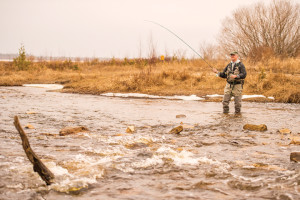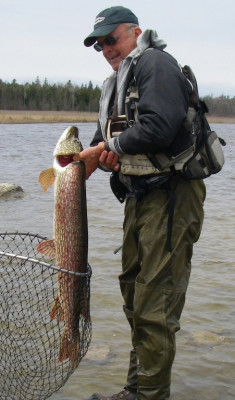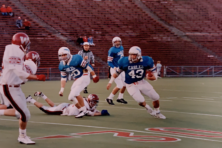Steve Osterhaus Casts in a County Not Known for Fly Fishing
- Share
- Tweet
- Pin
- Share

It may not be as renowned as Montana’s Bighorn River or the creeks twisting through Yellowstone, but a May evening on the Mink River in Ellison Bay is exactly where Steve Osterhaus wants to cast his flies.
“Any kind of fish that swims will basically take a fly,” he said. “It’s a matter of getting it to them, presenting it at the right time, in the right place, at the right speeds. There are a whole lot of things that go into it.”

Photo by Len Villano.
Osterhaus is a certified casting instructor from the Federation of Fly Fishers. He teaches casting and fly tying through his business, Peninsula Fly Casting. He spends winters in Georgia, but always returns in time for spring fishing in Door County.
Traditional fly fishing streams are clean, cold and stocked with native fish. The Mink River has a lot of that going for it – it’s protected by The Nature Conservancy and home to native Northern Pike and Smallmouth Bass – but it’s warmer water.
Fly fishing on the Mink River takes a different tack. Osterhaus usually uses wet flies that sink below the surface of the water and heavier gear. He fishes for Northern Pike, Smallmouth Bass and Walleye instead of cold-water trout.
Occasionally, casting a traditional dry fly works, too.
“I have had some unbelievable fishing experiences with dry flies on the Mink River in the evenings, to where I’ll catch 40 fish in an hour and a half – big smallmouth,” Osterhaus said. “I’ve had days where I catch zero. It just depends. That’s part of fishing… There have been days when [fly fishers] out-fish the bait anglers and the spin anglers 10 to one, and there have been days we don’t.”
Catching fish isn’t everything for Osterhaus and other fly fishing enthusiasts. It’s a romantic form of fishing, often catch-and-release, and has been heralded in literature like A River Runs Through It by Norman Maclean and Big Two-Hearted River by Ernest Hemingway.
“Fly fishing is a very cerebral sport,” Osterhaus said. “It’s you and nature, one on one. You’re not throwing big gear; you don’t have big 50-horse motorboats. You’re in the spring, wading in the waters.”
Fly fishing is occasionally seen as a highbrow form of fishing for much of the same reasons it’s romanticized by anglers, authors and movie producers. While people could spend thousands of dollars getting outfitted for the sport, Osterhaus said an investment in a decent rod, a pair of waders and a few flies is enough to get started.
“I find it just to be a very relaxing, contemplate-your-navel type of fishing,” he said. “You don’t need a lot of gear – a vest, waders, what you carry on your vest is what you have for the day: flies, food, water, extra this, extra that. Just go work the riffles, the riffled water.”
Working the water is also part of the fun. When beginners look at a river and see little but a placid current and a few overhanging branches, long-time anglers see where the fish are hiding and, accordingly, where they should cast their fly.
“You’ll learn how to read the water and it’s a challenge because every water is different,” Osterhaus said. “Every day is different.”
And the Mink River, like the classic fly fishing streams out West, is another water ripe for fly fishing.
“People say you can’t fly fish in Door County,” he said. “I beg to differ.”


